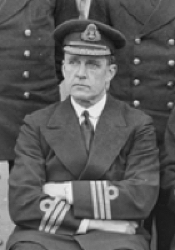Rear Admiral Henry Priaulx Cayley

Henry Priaulx Cayley was born on 29 December 1877 at Clifton, Bristol, England, son of Henry Cayley, Surgeon Major in the Indian Medical Service, and his wife Letitia Mary (née Walters). He was educated at Eastman's Naval Academy and in 1891 he joined Britannia Royal Naval College as a cadet. Following graduation he was promoted Midshipman in 1893 and Sub Lieutenant in 1897. His early sea-going appointments were to the Mediterranean Station and the Channel Fleet; then in 1899, after being commissioned Lieutenant, he served in the armoured cruiser HMS Undaunted during the Boxer Rebellion in China (1900-01). On 14 July 1906 he married Ethel Mary Hewitt at Kensington, London. Cayley was promoted Lieutenant Commander in 1907.
In 1909 Lieutenant Commander Cayley was posted to the Australia Station as the Royal Navy's inspector of warlike stores based in Sydney. In July 1913, Cayley was 35 years old and with limited prospects for promotion in the Royal Navy. He chose to transfer, as a Lieutenant, to the recently established Royal Australian Navy, retaining the position of inspector of warlike stores and in due course he was promoted Lieutenant Commander in the RAN. When war broke out in August 1914 he was made an Acting Commander and sailed with the first Australian convoy as Transport Officer in the troopship Euripides. Henry Cayley was then loaned back to the Royal Navy and took command of the cruiser HMS Isis in January 1915 and confirmed in the rank of commander in April. Isis served on the North America and West Indies station carrying out the essential but mundane patrol duties and preventing German merchant ships leaving neutral ports.
In March 1917 he was appointed as Executive Officer (second-in-command) of the light cruiser HMAS Sydney, then carrying out patrol and convoy escort duties in the North Sea. Sydney engaged no enemy ships but on 4 May 1917 she was attacked, in the North Sea, by the German Zeppelin L43. Cayley, in his typically humorous fashion, reported "differences of opinion" between his ship and a Zeppelin which "amused herself by sitting up overhead, well out of range, and thoroughly bombing us". Sydney was not hit, nor did any of her shells hit the Zeppelin. In November 1918 Sydney was one of the RAN warships which escorted the surrendering German High Sea Fleet into the Firth of Forth, Scotland. Cayley was promoted Captain on 1 April 1919 and took command of Sydney. He was a popular but firm commander, who took a humane interest in his men. In June 1919, when Sydney was returning home at the end of the war, Cayley was asked to help quell civil riots in the Straits Settlements. He promptly supplied landing parties at Singapore and Penang, and as an additional means of quietening unrest, is said to have ridden by rickshaw, in full uniform, through the streets of Penang.
Sydney ran aground (without damage) at Townsville, Queensland, in November 1919 and Cayley and his Navigating Officer were court-martialled and reprimanded for negligence. The findings against the navigator were quashed on appeal, but those against Cayley were confirmed. He was held solely responsible for the incident, however, he retained the confidence of Rear Admiral Dumaresq, who was then Commodore commanding the Australian Fleet, and the mishap does not appear to have prejudiced his chances of promotion. Cayley was also known to have a fiery temper at times and on one occasion when Sydney was entering harbour the Forecastle Officer made a mess of the evolution and overshot the bouy. Cayley yelled out from the bridge "you bloody fool" to which the Forecastle Officer politely replied "before you said that Sir, only you and I knew it - now the whole ship's company knows it" and Cayley had the good grace to agree. Captain Cayley relinquished command of Sydney in November 1922.
During November 1922-January 1923 Cayley was captain-in-charge of Flinders Naval Depot (HMAS Cerberus), Victoria before traveling to England for twelve months training. He completed a number of short courses including the Senior Officers' War Course, Senior Officers' Technical Course and the Anti-Gas Course. On his return to Australia he was appointed Second Naval Member, one of the few RAN officers to serve, before 1939, on the Australian Naval Board; appropriately he concerned himself mainly with personnel matters. In May 1927 he briefly took command of the light cruiser HMAS Melbourne before, in October of that year, being appointed as Captain Superintendent Sydney and Captain in Charge New South Wales with responsibilities for all naval facilities in that state; especially the operation of the Garden Island Dockyard.
Cayley was posted back to London in August 1929 as the naval representative on the Australian High Commissioner's staff but in 1931 this position was dis-established due to Depression defence spending cuts. Cayley retired on 7 August 1931 with the rank of Rear Admiral and spent the rest of his life in England. In retirement he devoted himself to Christian Science, the study of which had led him to abandon the Catholic faith and to become a tee-totaller. Survived by his son, he died of pulmonary embolism on 31 December 1942 at his home in Chelsea.


